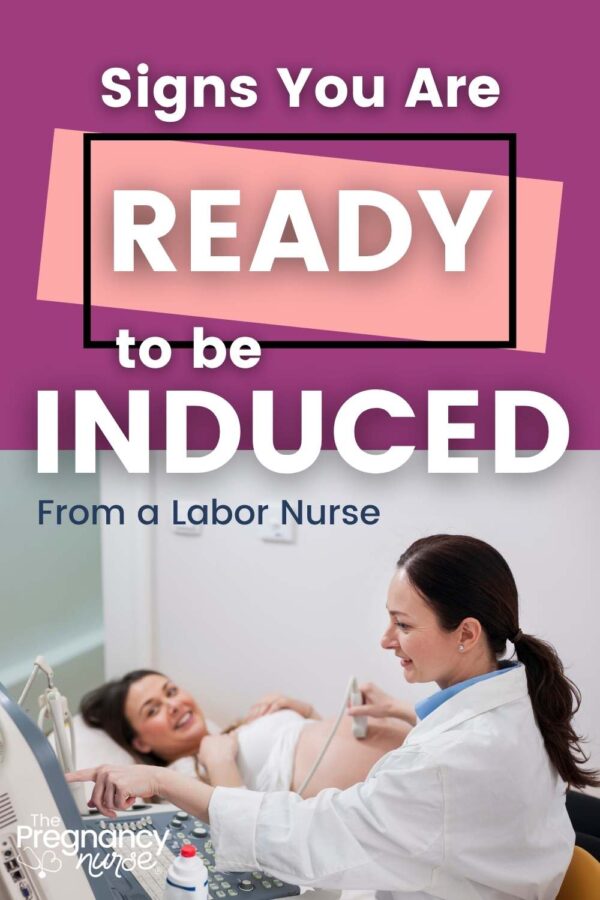There are a lot REASONS to be induced << and that post goes into it more — but today I want to talk about the signs you’re READY To be induced. They’re different, and I want to talk about why. All of this isn’t to say that there aren’t times that you NEED to be induced that you’re not READY, but I think this will be helpful for people who feel like they fall in the “grey zone” and aren’t sure how to make a choice.

This (or any article on The Pregnancy Nurse) should be taken as medical advice, this purely educational. Please talk with your provider about your specific needs and circumstances.
Before we get started, make SURE that you understand what you’re in for when you get induced. Many inductions fail mostly due to unmet expectations around birth — and I don’t want that for you, so I created this induction checklist that you can go through with your provider when you’re making your choice:
Your Choice
I want you to remember that induction is YOUR CHOICE. Your provider may say dumb things like:
- We’ll schedule you to be induced at 39 weeks
- I won’t let you go past 37 weeks with that blood pressure
- It’s time to schedule your induction
But that’s just them, being dumb — and not using their words right.
Induction is always your choice
I never want you to feel forced into an induction.
When you’re feeling pressured (or forced) into an induction, that’s the time to pause and get some questions answered. Hopefully this article will help answer a lot of those questions.
Pro Tip: inductions aren’t something that we do to save someone’s life right now. We a C-section if that needs doing. Inductions are something that take time, which means you have time to get your questions answered.
Ok, onto the signs you’re ready to be induced:
What’s Your Cervix?
You may have heard some smart talk like:
- Your cervix isn’t a crystal ball
- Your cervix doesn’t tell you anything
- Cervical exams are meaningless
But, as a nurse with experience since 2001 seeing inductions, I’m here to tell you that your cervix can tell us a lot.
Mostly, it tells us how ready your body is to go into labor.
Caveat: Bodies are weird, and some cervixes dilate very quickly (surprising us) and some just say where they are no matter what they do (surprising us) — so this is an art not a science, and bodies do what they want to do.
While providers just “know” after we check a cervix — we articulate that with something called the Bishop Score.
Honestly, every facility sort of has a different “scoring metric” — I like this one, but it just gives you an idea of what we’re looking for…. These are the usual things (want more info on the bishop’s score — see this)
- Dilation
- Effacement
- Station
- Position
- Consistency
Let’s give some examples:
If your cervix is closed thick and high (what most people’s cervix is until it starts to prepare for labor) — your score would be:
- Dilation 0 points
- Effacement 0 points
- Station 0 points
- Position 1 point (your cervix was easily reached)
- Consistency 0 points (your cervix was hard)
- Giving you a total of 1 point. This shows your cervix is likely not ready for labor, and it’s going to take a while.
Let’s say your cervix is 3 cm, 80% effaced and baby is -2, cervix is mid-position and feels “medium” (between hard and soft) This is a very normal “due” cervix…
- Dilation 2 points
- Effacement 3 points
- Station 2 points
- Position 1 point (your cervix was easily reached)
- Consistency 1 points (your cervix was hard)
- Giving you a total of 9 points (out of 13). This is a decent score. In our experience, your body could tolerate an induction pretty easily.
As a provider I very much know there is a BIG difference in an induction on someone with a 1 point bishop score, vs someone with 9 (or more) points.
Many facilities don’t offer an elective induction on lower bishop scores (the # depends on the facility). Likely it just takes too long, and in their experience those patients may be more likely need a cesarean.
While the ARRIVE trial didn’t take bishop score into their metrics, they did show an elective induction regardless of your bishop score doesn’t increase cesareans — but many people say their experience differs — I think both things should be acknowledged by patients (experience & the data). Want to know more about the arrive trial? I have a bonus video in here on it.
I think that knowing what your cervix shows is important before you head in for an induction. Most often providers want to check it so they know the medications they’ll order, etc. (cervix under 3 cm usually needs some cervical ripening first).
Want to know more about inductions — check out these posts:
- Pumping To Induce Labor? Will it work?
- 5 Things NOT to do Before Your Induction
- Pitocin to Induce Labor
- Inducing Labor at 39 Weeks: Pros and Cons
- 5 Reasons to NOT Get Induced
What is the Reason?
Now, we’re going to talk about OUR reasons here in a second — but I want to know why your provider wants to induce you.
Now induction reasons can really vary, including:
- Your blood pressure is too high, you might have a stroke
- I induce everyone at 39 weeks
As a reminder, providers don’t “induce us” — we CHOOSE to be induced, but I digress….
And then everything along that spectrum.
Honestly, there are very few black and white reasons in the land of induction. Many of them are things that we see “trending” towards something, and we figure we should give you the option to get the baby out.
However, if we go back to Sign #1 and you realize your bishop score is LOW — you might want to try some cervical prep on your own before getting induced.
OR, you decide — yeah, I think I’d rather not have a stroke, let’s do this.
You’re balancing what your provider is seeing (remember, they’re the expert in the room, but not the one that makes decisions) vs what you’re hoping for from your birth.
You’re not a horrible person to want to wait and get a bit more testing, or talk more about what your doctor is seeing beyond the test results.
For instance:
Your blood pressure is always high when you get back to the room, but settles nicely as your appointment progresses. Your provider thinks you should get induced, but you would prefer to get a blood pressure cuff and monitor it at home for a few days. You really don’t think your blood pressure is high, but you respect whey your provider would say that.
Your provider had an ultrasound done that showed your baby close to 8 pounds at 39 weeks. They encourage you to get induced so baby doesn’t get too big that you need a cesarean. You prefer to not get induced, so you probe your provider more about what they’re seeing as they monitor your belly from the outside, and consider getting another ultrasound in a few days. FYI, I have a whole post on what to do if your provider says you have a big baby that you might find helpful in this instance (that happens a lot).
You have gestational diabetes, and your blood sugars have been well-controlled. Your provider says they induce ALL diabetics by 39 weeks — but you know it’s your choice (not theirs). You ask them to check your cervix, and maybe order a size ultrasound as you make your mind up as to when you’re ready to be induced.
Again, in ALL of these instances, you’re pausing, asking questions, and deciding what’s right for YOU.
BTW, if you have NO idea what’s right for you — grab my birth plan tips here — it’s going to help you get clear on what’s important for your birth:
I don’t want you to think that I’m blithely typing here that you can just refuse any induction without consequence — we’re going to get to that, but I want you to remember that you get to make the choice (and also have the consequences). Keep reading!
Coping with Pregnancy
While we have mostly ignored this entire part of pregnancy, I think it’s important to think about how you’re coping with pregnancy, as it brings a lot to our bodies & our brains. Things like:
- How much pain you’re in daily
- Other health conditions it is exacerbating
- How you’ll manage other kids when you go into labor
- The relentless nature of prodromal labor that happens every night and you’re just over it.
All of these are valid.
Yes, there are people who will tell you to just tough it out — but the reality is that the arrive trial did show that a 39 week elective induction is safe. While there are always risks with an induction, there can also be risks to staying pregnant, including risks to your mental health.
I am not here to say that those reasons aren’t valid as well. They are. But, they have to be balanced, and you have to be aware of what you’re getting into.
So, you’re in a lot of pain, but they check your cervix and it’s still closed thick and high. You realize that being induced will not be a “quick fix” so you decide to take off work early and be as kind to yourself as you can.
Or, you’re 40 weeks, you have prodromal labor every night that toys with your emotions, your cervix is 4 cm, 90% effaced and baby is 0 station — you might realize an induction would stop you having to wonder every night if tonight is the night.
The key to all of this is balancing:
- How ready your uterus and cervix is for labor
- The important reasons your provider might be giving you
- Your mental health & how you’re managing life right now.
There are other factors, but I think these three are often what it boils down to.
Want to know more about induction?– check out these posts:
- What to Expect at A Foley Bulb Induction
- What Happens if Your Induction Doesn’t Work?
- How to Prepare for an Induction
- 6 Things to Know About Your Fetal Growth Ultrasound
- How to Ask Your Doctor to Induce You
But, right now I want to talk about:
The Case for Induction
People often get frustrated that providers want to induce so quickly. And I get that, I refused an induction on my 3rd baby until my cervix was VERY ready, but honestly I’m not sure she’d ever have come out if I hadn’t been induced.
But, there is a case for induction.
Many of the things I’ve talked about can increase your risk for still birth.
For a moment I want you to remember the devastation that a provider feels when their patient has a stillbirth. They think back to what they did wrong, how they could prevent it — and I bet you can understand how they want to avoid it at almost all costs.
As you head past week 39 your risk of stillbirth increases exponentially every day. Your placenta has a “shelf life” — and this is well known and studied.
Big babies can get caught in your pelvis with devastating consequences that we try to avoid at all costs. Which is why we take an ultrasound that is large very seriously. Even though ultrasounds can be off, they are often our best indicator of how big baby can be.
Provider see patients just miserable at the end of their pregnancy and they want to help them — so they offer inductions.
There are REASONS providers — the experts in the room — offer inductions, but it’s always you to balance those reason, what your body is showing and what you need.
It’s really easy to say early on “I won’t get induced” but as you see baby isn’t’ growing in the womb, or your blood pressure is out of control — you realize that you need the tools and skills to make choices in the moment. It’s just not a choice you can make earlier.
(You can, however say you’d prefer not to be induced — that’s fine, and important to know about yourself).
Why NOT to get induced? Overall, there is more risk and you do have a higher chance of a cesarean with an induction — but all that data must be taken (by an expert) and used for YOUR pregnancy and what your risks are at this point.
In order to make choices at the time you need:
- A provider you trust to be an expert
- A foundation of knowledge to draw from as you learn what’s going on (I recommend this one)
- Confidence that you know how to balance both what you need & what’s going on.
Honestly, I hear so many people saying their provider “forced” them to be induced because they ultimately didn’t want to make the choice, so they left it to the provider.
That brings on birth trauma, and a slew of other feelings.
Studies show that when you’re engaged in your care, and are making choices yourself (with their guidance, obviously) you’re much more likely to have a positive birth experience.
You may not feel confident — but I really recommend this to help you get that way and learn more about the choices you’ll have to make during labor, birth & postpartum.
So, take back the reigns, make the choice that suits you, and remember you can always change your mind (on most things) if things change.
Are you planning on an induction? Tell us in the comments!






 What You Need to Know About Wired vs Wireless Monitors in Labor
What You Need to Know About Wired vs Wireless Monitors in Labor
